SAN ANTONIO — We're tracking the latest numbers from the coronavirus pandemic in San Antonio and across Texas. Here are the latest numbers reported by Bexar and surrounding counties:
- Bexar County: 393 new cases and one additional fatality from COVID-19 were reported Sunday. There have been a total of 36,083 cases and 323 virus-related fatalities in the county.
- Comal County: The county reported 88 new cases on Saturday. Officials also confirmed the county's 45th death. There have been a total of 1,968 cases as of Saturday evening.
- Hays County: The county reported 42 new cases and a pair additional virus-related deaths on Friday. In all, 4,133 cases of COVID-19 have been confirmed in the county; 2,977 of those cases are considered active. The death toll is up to 24.
How Bexar County is trending
We're tracking how many coronavirus cases are confirmed in Bexar County each day from the time San Antonio Metro Health began reporting cases more than two months ago. Graphing those daily case numbers along a 14-day moving average provides an accurate picture of the curve in the San Antonio area and the direction we're heading amid the coronavirus.
On Sunday, Metro Health reported 393 new coronavirus cases in Bexar County, raising the total to 36,083.
Metro Health also reported one additional coronavirus-related death, bringing the county death toll to 323. Sunday's report was a welcome drop following a deadly week in Bexar County; each of the past five days has seen at least nine new fatalities from virus complications.

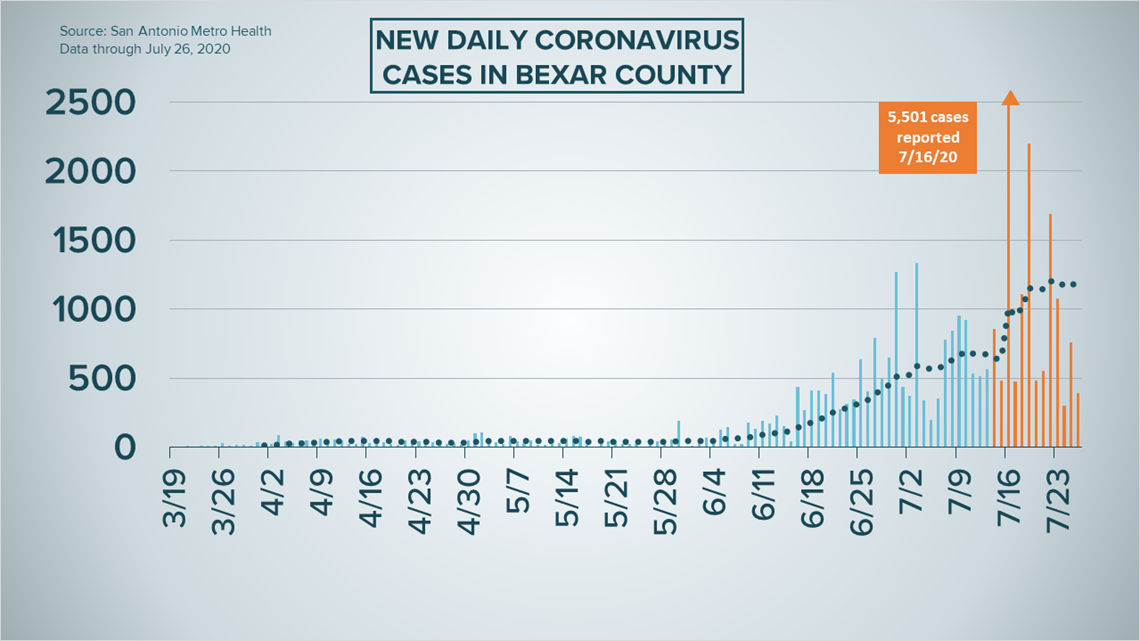

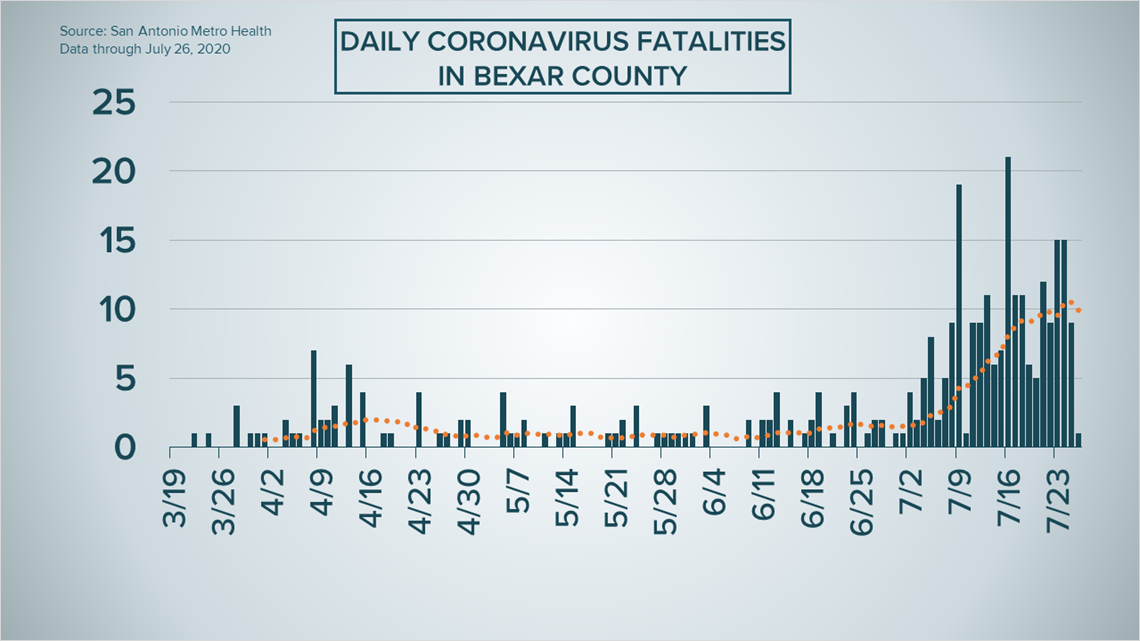
Hospitalizations continued to trend downward in Bexar County, with 1,044 residents receiving treatment for COVID-19 on Sunday. Sunday marks the seventh straight day that figure has decreased. The amount of COVID-19-positive patients in intensive care (418) and utilizing ventilators (287) are also down from Saturday.

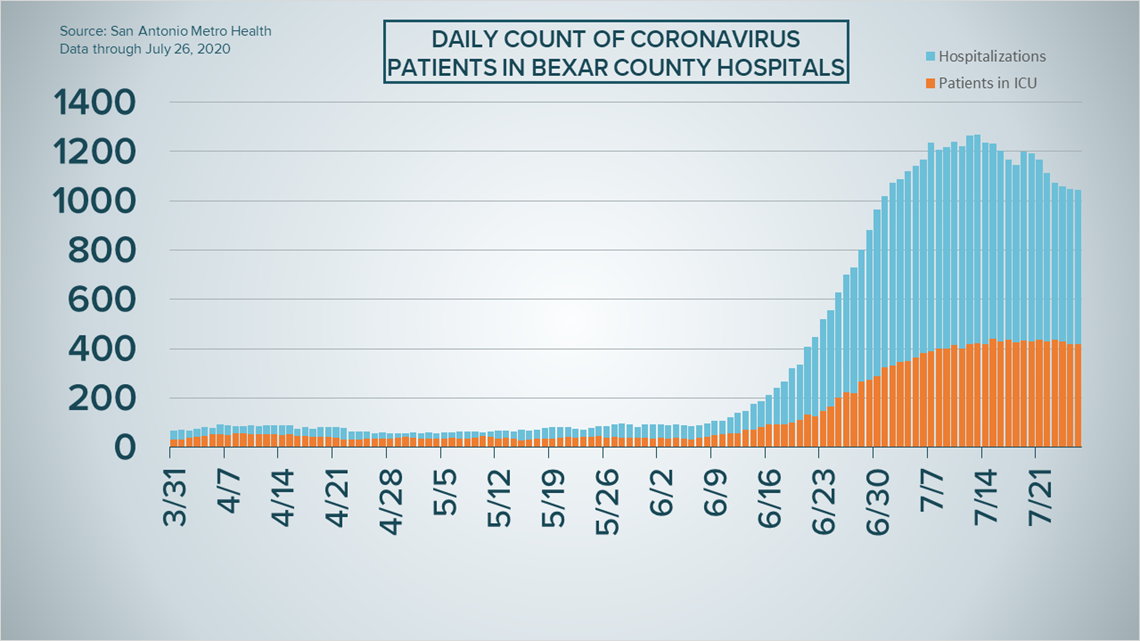
Coronavirus in Texas
State health officials on Sunday reported 5,810 additional cases of the novel coronavirus. In all, there have been 381,656 confirmed cases of COVID-19 during the ongoing pandemic.

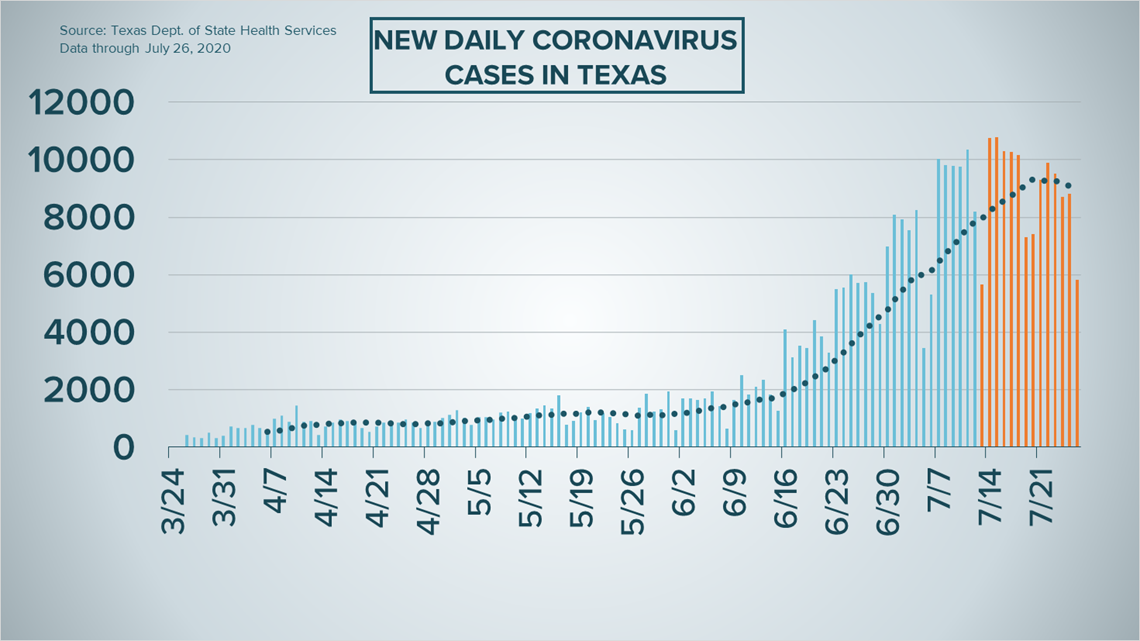
The rate of deaths also remained high on Sunday as Texas health authorities reported an additional 153 fatalities from COVID-19 complications. A total of 5,038 Texans have now lost their lives to the virus and issues stemming from it.

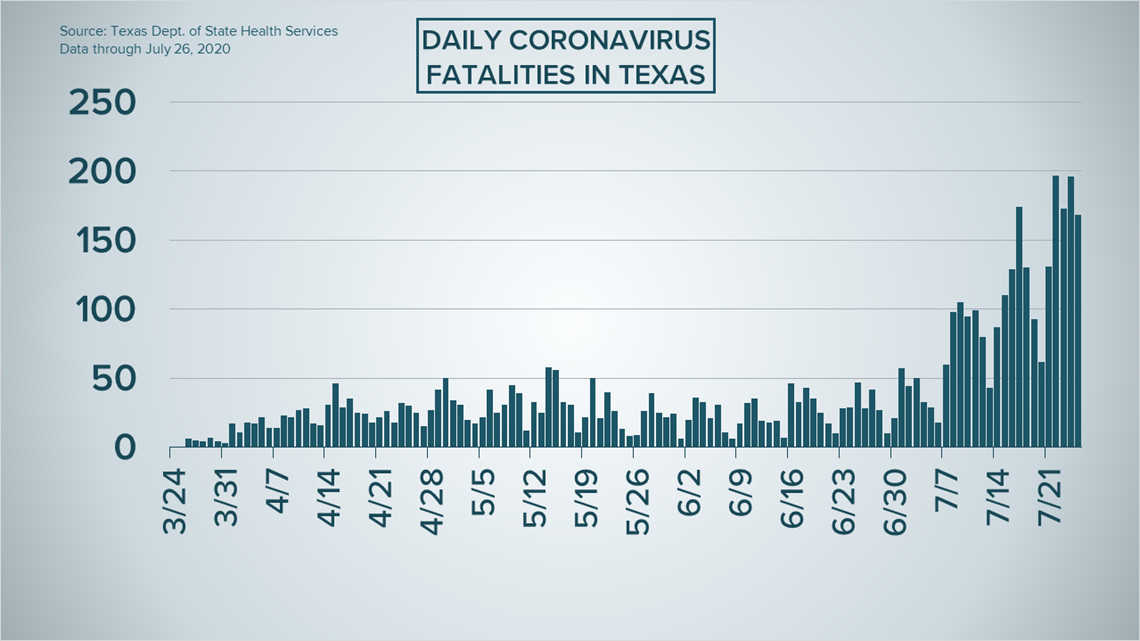
Meanwhile, for the fourth straight day, Texas says it's reporting incomplete hospitalizations data. The Department of State Health Services reported that 10,075 Texans are receiving treatment for COVID-19, but that represents information provided by just 85% of hospitals in the state.
The full statement from the department reads as follows:
DSHS is reporting incomplete hospitalization numbers 7/23-7/26 due to a transition in reporting to comply with new federal requirements. For July 26, 85 percent of hospitals reported complete data to DSHS, resulting in a partial data set and the appearance of a drop in hospitalizations. DSHS continues to work with Texas hospitals during this transition to ensure all facilities can fully report the data required.
An estimated 229,107 Texans have recovered, while 147,511 remain ill with the virus.
Latest Coronavirus Headlines
- Harris County Pct. 5 deputy dies from COVID-19
- What is contactless payment and why is it on the rise?
- Here's a list of retailers requiring face coverings for customers
- Coronavirus aid coming soon, with $1,200 checks by August, Treasury Secretary says
- Power of Sports: San Antonio Sport launches virtual fitness classes
- Funeral services held for Bexar County Emergency Management Coordinator Kyle Coleman
Coronavirus symptoms
The symptoms of coronavirus can be similar to the flu or a bad cold. Symptoms include fever or chills, cough, shortness of breath or difficulty breathing, fatigue, muscle or body aches, headache, new loss of taste or smell sore throat, congestion or runny nose, nausea or vomiting and diarrhea, according to the Centers for Disease Control.
Most healthy people will have mild symptoms. A study of more than 72,000 patients by the Centers for Disease Control in China showed 80 percent of the cases there were mild.
But infections can cause pneumonia, severe acute respiratory syndrome, kidney failure, and even death, according to the World Health Organization. Older people with underlying health conditions are most at risk.
On June 25, the CDC expanded the list of groups at a higher risk of severe illness due to coronavirus.
Experts determined there was consistent evidence these conditions increase a person's risk, regardless of age:
- Chronic kidney disease
- COPD (chronic obstructive pulmonary disease)
- Obesity (BMI of 30 or higher)
- Immunocompromised state (weakened immune system) from solid organ transplant
- Serious heart conditions, such as heart failure, coronary artery disease, or cardiomyopathies
- Sickle cell disease
- Type 2 diabetes
The CDC believes symptoms may appear anywhere from two to 14 days after being exposed.
Human coronaviruses are usually spread...
- Between people who are in close contact with one another (within about 6 feet).
- Through respiratory droplets produced when an infected person coughs, sneezes or talks. These droplets can land in the mouths or noses of people who are nearby or possibly be inhaled into the lungs.
- Some recent studies have suggested that COVID-19 may be spread by people who are not showing symptoms.
Help stop the spread of coronavirus
- Stay home when you are sick.
- Eat and sleep separately from your family members
- Use different utensils and dishes
- Cover your cough or sneeze with your arm, not your hand.
- If you use a tissue, throw it in the trash.
Lower your risk
- Wash your hands often with soap and water for at least 20 seconds. If soap and water are not available, use an alcohol-based hand sanitizer.
- Avoid touching your eyes, nose, and mouth with unwashed hands.
- Avoid close contact with people who are sick.
- Clean and disinfect frequently touched objects and surfaces.
- The CDC recommends wearing a mask or cloth face covering if you have to be out due to an essential service or essential activity such as going to the grocery store.
- If you are 60 or over and have an underlying health condition such as cardiovascular disease, diabetes or respiratory illnesses like asthma or COPD, the World Health Organization advises you to try to avoid crowds or places where you might interact with people who are sick.

